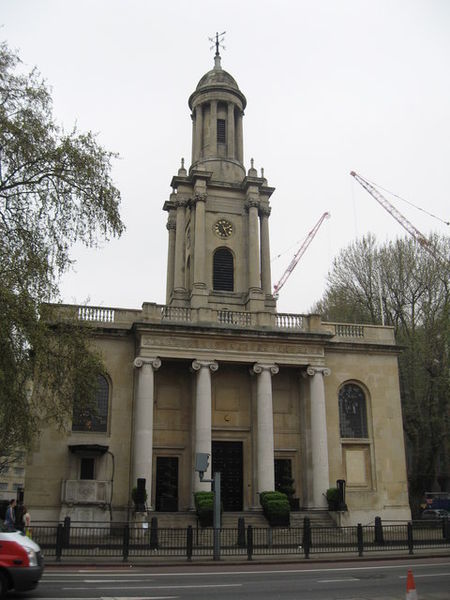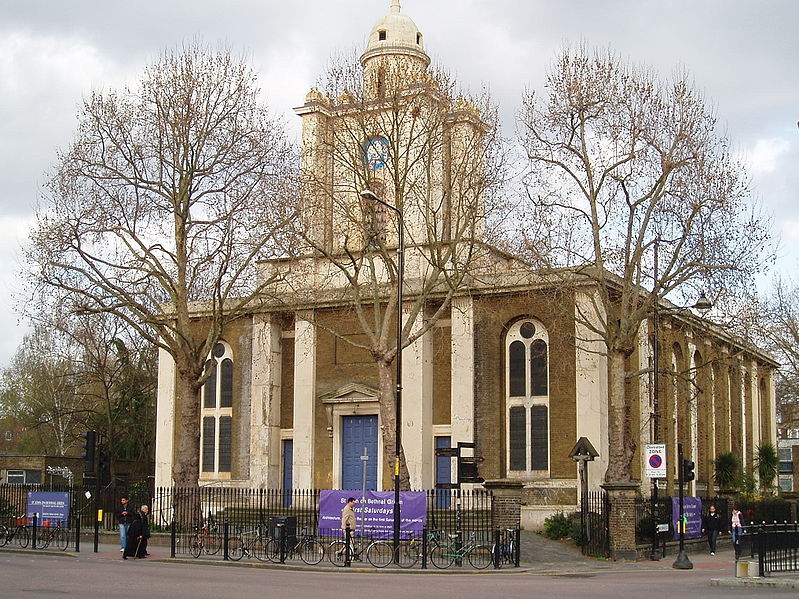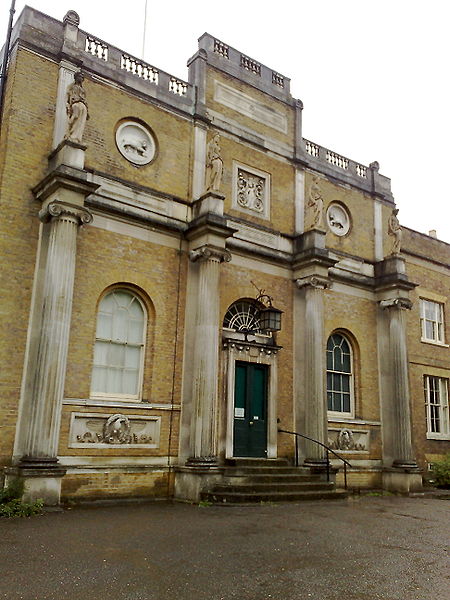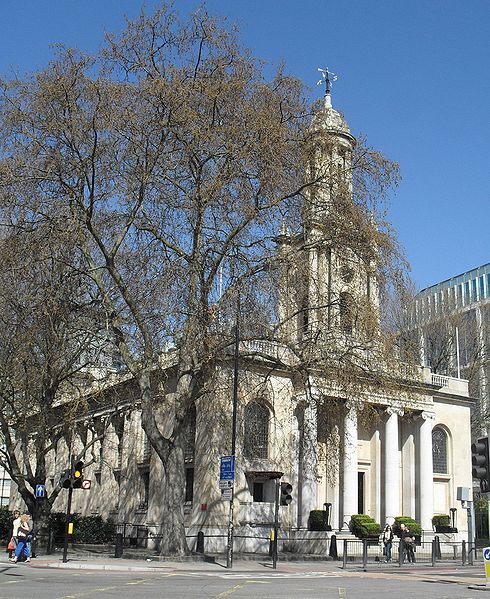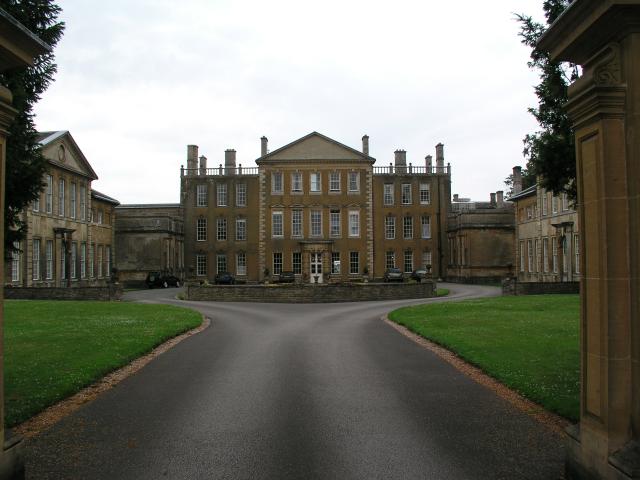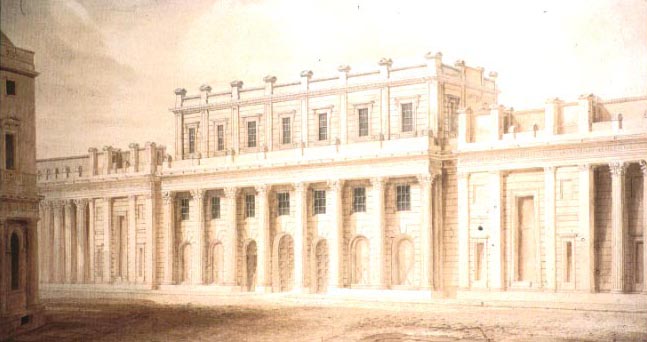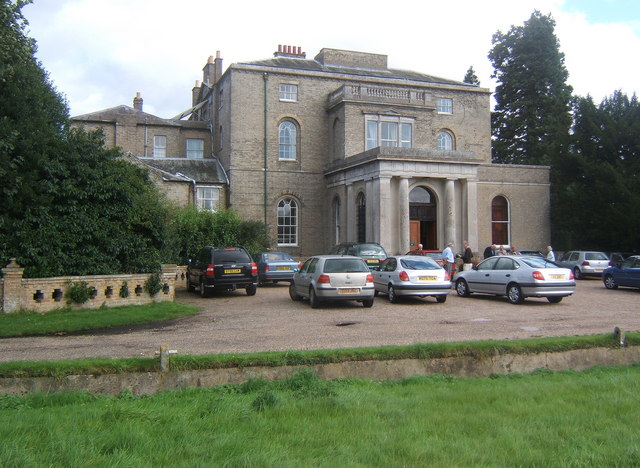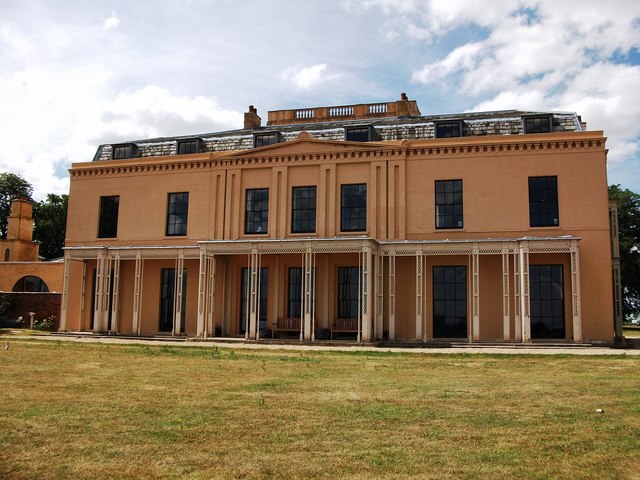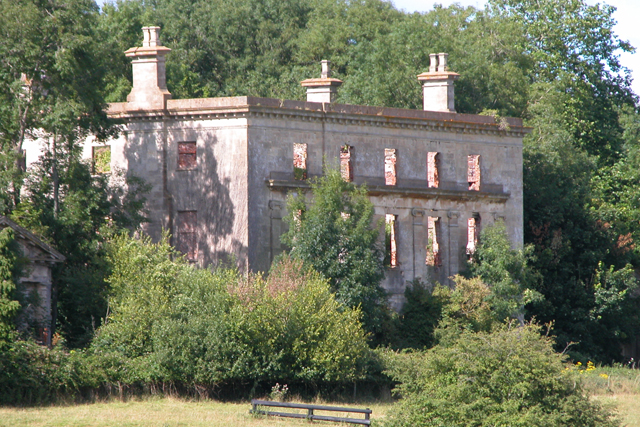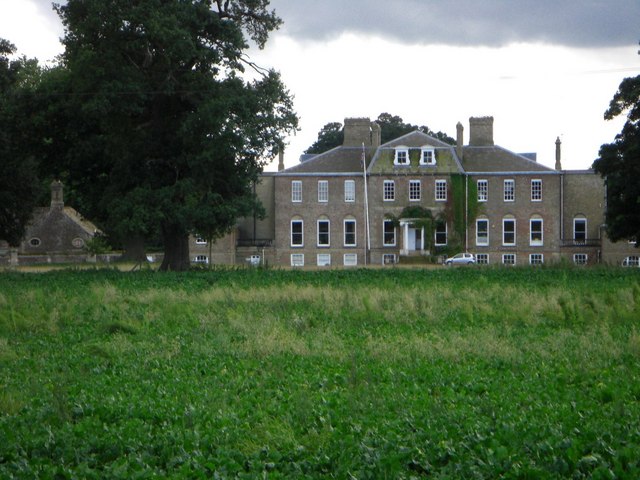<Back to Index>
- Architect John Soane, 1753
PAGE SPONSOR
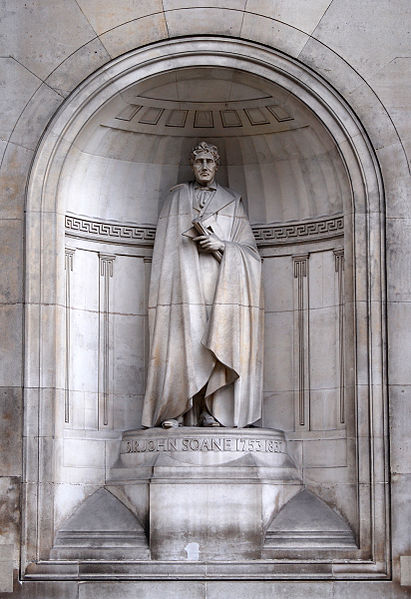
Sir John Soane, RA (10 September 1753 – 20 January 1837) was an English architect who specialized in the Neo-Classical style. His architectural works are distinguished by their clean lines, massing of simple form, decisive detailing, careful proportions and skillful use of light sources. The influence of his work, coming at the end of the Georgian era, was swamped by the revival styles of the 19th century. It was not until the late 19th century that the influence of Sir John's architecture was widely felt. His best known work was the Bank of England (his work there is largely destroyed), a building which had widespread effect on commercial architecture. His major legacy is Sir John Soane's Museum, in Lincoln's Inn Fields, London, formed from his former home and office to display art works and architectural artifacts that he collected during his lifetime.
Soane was born in Goring - on - Thames on the 10 September 1753 he was the second surviving son of John Soan (the 'e' was added by the architect to the name in 1784 on his marriage) and his wife Martha. His father was a builder or bricklayer, his father dying when Soane was fourteen in April 1768. He was educated in nearby Reading in a private school run by William Baker. After his father's death the family moved to nearby Chertsey to live with Soane's elder brother William (he was born 12 years before Soane), also a bricklayer.
His brother introduced Soane to James Peacock a surveyor who worked with George Dance the Younger. Soane began his training as an architect under George Dance the Younger at age 15, he joined the architect at his home and office in the City of London at the corner of Moorfields and Chiswell Street. Dance was a founder member of the Royal Academy and doubtless encouraged Soane to join the schools (they were free) there on 25 October 1771, there he would have attended the architecture lectures delivered by Thomas Sandby and the lectures on perspective delivered by Samuel Wale, Soane would also of had access to the library at the Royal Academy.
Dance's growing family was probably the reason that in 1772 Soane
continued his education by joining the household and office of Henry Holland (architect),
he recalled 'placed in the office of an eminent builder in extensive
practice where I had every opportunity of surveying the progress of
building in all its different varieties, and of attaining the knowledge
of measuring and valuing artificers' work'.
During his studies at the Royal Academy, he was awarded the Academy's
silver medal on 10 December 1772 for a measured drawing of the facade of the Banqueting House, Whitehall, and the gold medal 1776 for his design of a Triumphal Bridge, and finally a traveling scholarship in December 1777. In 1777 he exhibited at the Royal Academy a design for a Mausoleum for his friend and fellow student James King, who had drowned in 1776 on a boating trip to Greenwich,
when the boat overturned, Soane a non - swimmer was going to be with the
party but decided to stay home and work on his design for a Triumphal Bridge. In 1778 he published his first book Designs in Architecture. Using his traveling scholarship (£60 per annum for three years, plus an additional £30 traveling expenses for each way), having been advised by Sir William Chambers on what to study
he advised 'Always see with your own eyes... [you] must discover their
true beauties, and the secrets by which they are produced', he set sail for his Grand Tour, his ultimate destination being Rome at 5:00 a.m. 18 March 1778.
His traveling companion was Robert Furze Brettingham, they traveled via Paris, where they visited Jean - Rodolphe Perronet, they went onto the Palace of Versailles on the 29 March. They finally reached Rome on 2 May 1778. Soane wrote home 'my attention is entirely taken up in the seeing and examining the numerous and inestimable remains of Antiquity...'. Soane's first dated drawing is 21 May of Sant' Agnese fuori le mura. Soane's former classmate, the architect Thomas Hardwick returned to Rome in June from Naples and he and Soane would produced a series of measured drawings and ground plans of Roman buildings together. During the summer he visited Hadrian's Villa and the Temple of Vesta, Tivoli, back in Rome he investigated the Colosseum. In August he was working on a design for a British Senate House to be submitted for the 1779 Royal Academy summer exhibition.
In the autumn he met the builder and Bishop of Derry, Frederick Augustus Hervey, 4th Earl of Bristol, the Earl presented copies of I quattro libri dell' architettura and De architectura to Soane. In December the Earl introduced Soane to Thomas Pitt, 1st Baron Camelford this would lead eventually to architectural commissions. The Earl persuaded Soane to accompany him to Naples setting off from Rome on 22 December 1778, on the way they visited Capua and the Palace of Caserta arriving in Naples on 29 December. It was in Naples that Soane met two future clients, John Patteson and Richard Bosanquet. From Naples Soane made several excursions including: Pozzuoli, Cumae, Pompeii where he met yet another future client Philip Yorke. Soane also attended a performance at Teatro di San Carlo and climbed Mount Vesuvius. Visting Paestum, Soane was deeply impressed by the Greek temples, next he visited the Certosa di Padula, then on to Eboli and Salerno and its cathedral, later they visited Benevento and Herculaneum. The Earl and Soane left for Rome on 12 March 1779, traveling via Capua; Gaeta; the Pontine Marshes; Velletri; Alban Hills and Lake Albano; Castel Gandolfo, back in Rome they visited the Palazzo Barberini, and witnessed the celebrations of Holy Week, shortly after the Earl and his family departed for home, followed a few weeks later my Thomas Hardwick.
It was now that Soane met Maria Hadfield (they became life long friends) and Thomas Banks, Soane was now fairly fluent in the Italian language, all signs of his growing confidence. It was now that a party of British men, Thomas Bowdler, Rowland Burdon, John Patteson, John Stuart and Henry Grewold Lewis, decided to visit Sicily and paid for Soane to accompany them as a draughtsman. The party headed for Naples on 11 April, where on 21 April they caught a Swedish ship to Palermo, Soane visited the Villa Palagonia, which made a deep impact on him. Leaving Palermo from there the party split, Stuart and Bowlder going off together, the rest headed for Segesta, Trapani, Selinunte and Agrigento, exposing Soane to Ancient Greek architecture. From Agrigento the party headed for Licata where they sailed for Malta and Valletta returning on 2 June, to Syracuse, Sicily, moving on to Catania and Palazzo Biscari then Mount Etna, Taormina, Messina and the Lepari Islands. They were back in Naples by 2 July where Soane purchased books and prints, visiting Sorrento before returning to Rome. Shortly after John Patterson returned to England via Vienna from which he sent Soane the first six volumes of The Life and Opinions of Tristram Shandy, Gentleman, delivered by Antonio Salieri.
In Rome Soane's circle now included Henry Tresham, Thomas Jones (artist) and Nathaniel Marchant. Soane continued to study the buildings of Rome including the Basilica of St. John Lateran. Soane and Rowland Burdon set out in August for Lombardy, their journey include visits to Ancona, Rimini, Bologna, Parma and its Accademia, Milan, Verona, Vicenza and its buildings by Andrea Palladio, Padua, the Brenta (river) with its villas by Palladio, Venice; then back to Bologna where Soane copied designs for completing the west front of San Petronio Basilica including ones by Palladio, Vignola and Baldassare Peruzzi; then to Florence and the Accademia delle Arti del Disegno of which he was later in January 1780 elected a member ; then returned to Rome.
Soane continued his study of buildings, including Villa Lante, Palazzo Farnese, Palazzo Massimo alle Colonne, the Capitoline Museums and the Villa Albani. That autumn he met Henry Bankes, Soane prepared plans for the Banke's house Kingston Lacy but these came to nothing.
Early in 1780 Frederick Augustus Hervey, 4th Earl of Bristol wrote to
Soane offering him various architectural commissions, Soane decided to
return to England and began to organize his return journey, he left Rome
on 19 April 1780, traveling with the Reverand George Holgate and his
pupil Michael Pepper. They visited the Villa Farnese, then on to Siena, then Florence where they visited the Palazzo Pitti, Uffizi, Santo Spirito, Florence, Giotto's Campanile and other sites. Performing at the Teatro della Pergola was Nancy Storace with whom Soane formed a life long friendship. Their journey continued on via Bologna, Padua, Vicenza, Verona, Mantua where he sketched Palazzo del Te, Parma, Piacenza, Milan where he attended La Scala the theater was a growing interest, Lake Como from where they began their crossing of the Alps via the Splügen Pass. They then passed on to Zurich, Reichenau, Switzerland, Wettingen, Schaffhausen, Basel
on the way to which the bottom of Soane's trunk came loose on the coach
and spilled the contents behind it, he thus lost many of his books,
drawings, drawing instruments, clothes and his gold and silver medals
from the Royal Academy (none of which was recovered). He continued his journey on to Freiburg im Breisgau, Cologne, Liège, Leuven and Brussels before embarking for England.
After a brief stop in London (thanks to his Grand Tour he was £120 in debt), Soane headed for Frederick Augustus Hervey, 4th Earl of Bristol's estate at Ickworth House in suffolk, where the Earl was planning to build a new house. But immediately the Earl changed his mind and dispatched Soane to Downhill House, County Londonderry, in Ireland, where Soane arrived on 27 July 1780. The Earl had grandiose plans to rebuild the house, but Soane and the Earl disagreed over the design and parted company, Soane receiving only £30 for his efforts. He left via Belfast sailing to Glasgow. From Glasgow he traveled to Allanbank, Scottish Borders, home of a family by the name of Stuart he'd met in Rome, he prepared plans for a new mansion for the family, but again the commission came to nothing. In early December 1780 Soane took lodgings at 10 Cavendish Street London. To pay his way his friends from the Grand Tour, Thomas Pitt and Philip Yorke gave him commissions for repairs and minor alterations. Anna, Lady Miller considered building a temple in her garden at Batheaston to Soane's design and he hoped he might receive work from her circle, but again this was not be so. To help him out, George Dance gave Soane a few measuring jobs, including during May 1781 on his repairs to Newgate Prison caused by the Gordon Riots.
To give Soane some respite, Thomas Pitt invited him to stay in 1781 at his Thamesside villa of Petersham Lodge which Soane was commissioned to redecorate and repair. Also in 1781 Philip Yorke gave Soane commissions, at his home Hamels Park in Hertfordshire, he designed a new entrance gate and lodges, followed by a new dairy and alterations to the house, and in London alterations and redecoration of 63 New Cavendish Street. Increasingly desperate for work Soane entered a competition in March 1782 to design a prison, but failed to win. Soane continued to get other minor design work in 1782.
It wasn't until 1783 that Soane received his first commission for a new country house, Letton Hall, Norfolk, the house was a fairly modest villa but it was a sign that at last Soane's career was taking off and led to other work in East Anglia; Saxlingham Rectory in 1784 and Shotesham Hall, Shotesham in 1785. Tendring Hall, Suffolk, (1784 – 86) was another commission in and the remodeling of Ryston Hall (1787)
From the mid 1780s on Soane would receive a steady stream of commissions until his semi - retirement in 1832. Including: Piercefield House (1784) now a ruin; the remodeling of Chillington Hall (1785); The Manor, Cricket St Thomas (1786); Bentley Priory (1788); the Chapel at New Wardour Castle (1788). An important commission in terms of the client, were alterations to William Pitt the Younger's house at Holwood House in 1786, Soane had befriended William Pitt's uncle Thomas on his grand tour; In (1787) Soane remodeled the interior of Fonthill Splendens (later replaced by Fonthill Abbey) for Thomas Beckford, adding a picture gallery lit by two domes and other work.
On 16 October 1788, he succeeded Sir Robert Taylor as architect and surveyor to the Bank of England, he would work at the bank for the next 45 years, given Soane's youth and relative inexperience his appointment was down to the influence of William Pitt then the Prime Minister
and his friend from the Grand Tour Richard Bosanquet whose brother was
Samuel Bosanquet, Director (later Governor) of the Bank of England. His salary was set at 5% of the cost of any building works at the Bank, paid every six months.
Soane would virtually rebuild the entire bank, and vastly extend it.
The main banking halls were based on the same basic layout, starting
with the Bank Stock Office of 1791 - 96, consists of a rectangular room,
the center with a large lantern light supported by piers and pendentives,
then the four corners of the rectangle have low vaulted spaces, and in
the center of each side compartments rising to the height of the arches
supporting the central lantern, the room is vaulted in brick and windows
are iron framed to ensure the rooms are as fire proof as possible.
His work at the bank was:
- Erection of Barracks for the Bank Guards and rooms for the Governor, officers and servants of the Bank (1790).
- Between 1789 and February 1791 Soane oversaw acquisition of land northwards along Princes Street.
- The erection of the outer wall along the newly acquired land 1791.
- Erection of the Bank Stock Office the first of his major interiors at the bank, with its fire proof brick vault (1791 – 96).
- The erection of The Four Percent Office (replacing Robert Taylor's room) (1793).
- The erection of the Rotunda (replacing Robert Taylor's rotunda) (1794).
- The erection of the Three Percent Consols Transfer Office (1797 – 99).
- Acquisition of more land to the north along Bartholomew Lane, Lothbury and Prince's Street (1792).
- Erection of outer wall along the north - east corner of the site, including an entrance arch for carriage (1794 – 98).
- Erection of houses for the Chief Accountant and his deputy (1797).
- The erection of the Lothbury Court within the new gate, used to receive Bullion (1797 – 1800).
- Extension of the Bank to the north - east, the exterior wall was extended around the junction of Lothbury and Princes Street, forming the 'Tivoli Corner' which is based on the Temple of Vesta, Tivoli that Soane had visited and much admired, halfway down Princes street he created the Doric Vestibule as a minor entrance to the building and within two new courtyards that were surrounded by the rooms he built in 1790 and new rooms including printing offices for banknotes, the £5 Note Office and new offices for the Accountants, the Bullion Office off the Lothbury Court (1800 – 1808).
- Rebuilding of the vestibule and entrance from Bartholmew Lane (1814 – 1818).
- The rebuilding of Robert Taylor's 3 Percent Consols Transfer Office and 3 Percent Consols Warrant Office and completion of the exterior wall around the south - east and south - west boundaries including the main entrance in the center of Threadneedle Street (1818 – 1827).
In 1807 Soane designed New Bank Buildings on Princes Street for the Bank, consisting of a terrace of five mercantile residences, which were then leased to prominent city firms.
The Bank being his most famous work, Sir Herbert Baker's rebuilding of the Bank, demolishing most of Soane's earlier building was described by Nikolaus Pevsner as "the greatest architectural crime, in the City of London, of the twentieth century". The Bank job, and especially the personal contacts arising from it, increased the success of Soane's practice.
A growing sign of Soane's success was an invitation to be a founder member of the Architects' Club that was formed on 20 October 1791, practically all the leading practitioners in London were members, and it combined a meeting to discuss professional matters, at 5:00p.m. on the first Thursday of every month with a dinner. The four founders were Soane's former teachers George Dance and Henry Holland with, James Wyatt and Samuel Pepys Cockerell. Other original members included: Sir William Chambers, Thomas Sandby, Robert Adam, Matthew Brettingham the Younger, Thomas Hardwick and Robert Mylne. Members who later joined included Sir Robert Smirke and Sir Jeffry Wyattville.
On the 20 January 1807 Soane was made clerk of works of Royal Hospital Chelsea, he held the post until his death thirty years later, it paid a salary of £200 per annum. His designs were: built 1810 a new infirmary (destroyed in 1941 during The Blitz), a new stable block and extended his own official residence in 1814; a new bakehouse in 1815; a new gardener's house 1816, a new guard house and Secretary's Office with space for fifty staff 1818; a Smoking Room in 1829 and finally a garden shelter in 1834.
Soane who was a freemason was employed to extend Freemasons' Hall, London in 1821 by building a new gallery, later in 1826 he prepared various plans for a new hall, but it was only built in 1828 - 1831, including a council chamber, and smaller room next to it and a staircase leading to a kitchen and scullery in the basement, the building was demolished to make way for the current building.
Between 1795 and 1799 Soane was Deputy Surveyor of His Majesty's Woods and Forest, on a salary of £200 per annum. James Wyatt's death in 1813 led to Soane together with John Nash and Robert Smirke, being appointed official architect to the Office of Works in 1813 (the appointment ended in 1832), at a salary of £500 per annum. As part of this position he was invited to advise the Parliamentary Commissioners on the building of new churches from 1818 onwards. He was required to produce designs for churches to seat 2000 people for £12,000 or less though Soane thought the cost too low, of the three churches he designed for the Commission all were classical in style. The three churches were: St Peter's Church, Walworth (1823 – 24) for £18,348; Holy Trinity Church Marylebone (1826 – 27) for £24,708; St. John's Bethnal Green (1826 – 28) for £15,999. Then, in 1814, he was appointed to the Metropolitan Board of Works, where he remained until his retirement in 1832.
Soane designed several public buildings in London, including: National Debt Redemption Office (1817) demolished 1900; Insolvent Debtors Court (1823) demolished 1861; Privy Council and Board of Trade Offices, Whitehall (1823 – 24) remodeled by Sir Charles Barry the building now houses the Cabinet Office; in a new departure for Soane he used the Italianate style for The New State Paper Office, (1829 – 1830) demolished 1868 to make way for the Foreign and Commonwealth Office building. In Dublin, Soane was commissioned by the Bank of Ireland to design a new headquarters for the triangular site on Westmoreland Street now occupied by the Westin Hotel. However, when the Irish Parliament was abolished in 1800, the Bank abandoned the project and instead bought the former Parliament Buildings.
Country homes for the landed gentry included: new rooms and remodeling of Wimpole Hall and garden buildings , (1790 – 94) for his friend Philip Yorke that he met on his Grand Tour; remodeling of Baronscourt, County Tyrone, Ireland (1791); Tyringham Hall (1792 – 1820); the remodeling of Aynhoe Park (1798); In 1804 Soane remodeled Ramsey Abbey none of his work there now surives; the remodeling of the south front of Port Eliot and new interiors (1804 – 06); the Gothic Library at Stowe House (1805 – 06); Moggerhanger House (1791 – 1809); for Marden Hill, Hertfordshire, Soane designed a new porch and entrance hall (1818); remodeling of Wotton House after damage by fire (1820); a terrace of six houses above shops in Regent Street London, (1820 – 21) demolished; Pell Wall Hall (1822). Among Soane's most notable works are the dining rooms of both numbers 10 and 11 Downing Street (1824 – 26) for the Prime Minister and Chancellor of Britain.
In 1811, Soane was appointed as architect for Dulwich Picture Gallery, the first purpose built public art gallery in Britain, to house the Dulwich collection, which had been held by art dealers Sir Francis Bourgeois and his partner Noel Desenfans. Bourgeois's will stipulated that the Gallery should be designed by his friend John Soane to house the collection. Uniquely the building also incoporates a Mausoleum containing the bodies of Francis Bourgeois, and Mr and Mrs Desenfans. The Dulwich Picture Gallery was completed in 1817. The five main galleries are lit by elongated roof lanterns, thus freeing the walls from reflections and maximising the wall area for paintings and it has influenced the design of art galleries ever since.
As an official architect of the Office of Works Soane was asked to design the New Law Courts at Westminster Hall, he began surveying the building on 12 July 1820. Soane was to extend the law courts along the west front of Westminster Hall providing accommodation for five courts: The Court of Exchequer, Chancery, Equity, King's Bench and Common Pleas. The foundations were laid in October 1822 and the shell of the building completed by February 1824. Then Henry Bankes launched an attack on the design of the building, as a consequence Soane had to demolish the facade and set the building lines back several feet and redesign the building in a gothic style instead of the original classical design (Soane rarely designed gothic buildings). The building opened on 21 Januray 1825, and remained in use until the Royal Courts of Justice opened in 1882, after this the building was demolished in 1883 and the site left as lawn. All the court rooms displayed Soane's typically complex lighting arrangements, being top lit by roof lanterns often concealed from direct view.
In 1822 as an official architect of the Office of Works, Soane was asked to make alteration to the House of Lords at the Palace of Westminster. He added a curving gothic arcade with an entrance leading to a courtyard, a new Royal Gallery, main staircase and Ante - Room, all the interiors were in a grand neo - classical style, completed by January 1824. Later four new committee rooms, a new library for the House of Lords and for the House of Commons alterations to the Speaker of the House of Commons house, and new library, committee rooms, clerks' rooms and stores, all would be destroyed in the fire of 1834.
One of Soane's largest designs was for a new Royal Palace in London, a series of designs were produced c.1820 - 1830.
The design was unusual in that the building was triangular, there were
grand porticoes at each corner and in the middle of each side of the
building, the center of the building consisted of a low dome, with
ranges of rooms leading to the entrances in each side of the building,
creating three internal courtyards.
As far as is known it is not related to an official commission and was
merely a design exercise by Soane, indeed the various drawings he
produced date over several years, he first produced a design for a Royal
Palace while in Rome in 1779.
The Royal Academy was at the very center of Soane's architectural career, in the sixty four years from 1772 to 1836 there were only five years, 1778 and 1788 - 91 in which he did not exhibit any designs there. After Thomas Sandby died in 1798, George Dance, Soane's old teacher was appointed professor of architecture at the Academy, but during his tenure of the post failed to deliver a single lecture. Naturally this caused dissatisfaction, and Soane began to maneuver to obtain the post for himself. Eventually Soane succeeded in ousting Dance and became professor on 28 March 1806, although Soane did not deliver his first lecture until 27 March 1809. He did not begin to deliver the full series of twelve lectures until, January 1810. All went well until he reached his fourth lecture on 29 January 1810, in it he criticized several recent buildings in London, including George Dance's Royal College of Surgeons of England and his former pupil Robert Smirke's Covent Garden Theatre. Naturally Royal Academicians Robert Smirke (painter) father of the architect and his friend Joseph Farington led a campaign against Soane, as a consequence the Royal Academy introduced a rule forbidding criticism of a living British artist in any lectures delivered there. Soane attempted to resist what he saw as interference and it was only under threat of dismissal that he finally amended his lecture and recommenced on 12 February 1813 the delivery of the first six lectures. The rift that all this caused between Soane and George Dance would only be healed in 1815 after the death of Mrs Soane.
The twelve lectures, they were treated as two separate courses of six lectures, were all extensively illustrated with many drawings and building plans, they were:
- Lecture I - traced 'architecture from its most early periods' and covered the origin of civil, military and naval architecture.
- Lecture II - outlined the Classical architecture of the ancient world continuing on from the first lecture.
- Lecture III - an analysis of the five Classical orders, their application and the use of Caryatids.
- Lecture IV - use of the classical orders structurally and decoratively and for commemorative monuments.
- Lecture V - the history of architecture from Constantine the Great and the Decline of the Roman Empire to the rise of Renaissance architecture, followed by a survey of British architecture from Inigo Jones to William Chambers (architect).
- Lecture VI - covered arches, bridges the theory and symbolism of architectural ornament.
- Lecture VII - appropriate character in architecture and the correct use of decoration.
- Lecture VIII - the distribution and planning of rooms and staircases.
- Lecture IX - the design of windows, doors, pilasters, roofs and chimney shafts.
- Lecture X - landscape architecture and garden buildings.
- Lecture XI - a discussion of the architecture and planning of London contrasting it with Paris.
- Lecture XII - a discussion of construction methods and standards.
Soane over the course of his career built up an extensive library of 7,783 volumes, this is still housed in the library he designed in his home now museum of 13 Lincoln's Inn Fields. The library covers a wide range of subjects: Greek and Roman classics, poetry, painting, sculpture, history, music, drama, philosophy, grammars, topographical works, encyclopedia's, runs of journals and contemporary novels.
Naturally architectural books account for a large part of the library, and was very important when he came to write his lectures for the Royal Academy. The main architectural books include: several editions of Vitruvius's De architectura, including Latin, English, French and Italian editions, including the commentary on the work by Daniele Barbaro; Julien - David Le Roy's Les Ruines des plus beaux monuments de la Grèce; Johann Joachim Winckelmann's Geschichte der Kunst des Alterthums, in its french translation bought in 1806 just before Soane was appointed to the professorship; Marc - Antoine Laugier's Essai sur l'Architecture; Jacques - François Blondel's nine volumes of Cours d'architecture ou traité de la décoration, distribution et constructions des bâtiments contenant les leçons données en 1750, et les années suivantes; Six works by Quatremère de Quincy, including the Dictionnaire historique de l'Architecture. These are some of the major thinkers who influenced Soane and his own writings.
Soane also acquired several illuminated manuscripts: a 13th century English Vulgate Bible; a 15th century Flemish copy of Josephus's works; four book of hours, two Flemish of the 15th century and early 16th century, Dutch of the late 15th century and French 15th century; a French missal dated 1482; Le Livre des Cordonniers de Caen, French 15th century; Marino Grimani's commentary of the Epistle of St. Paul to the Romans the work of Giulio Clovio.
Other manuscripts include: Francesco di Giorgio's mid 16th century Treatise of Architecture; Nicholas Stone's two account books covering 1631-42, and his son also Nicholas Stone Sketch Book (France & Italy) 1648 and Henry Stone's sketch book 1638; Margaret Cavendish, Duchess of Newcastle - upon - Tyne's The Second Epistle; James Gibbs's A few short cursory remarks on buildings in Rome; Joshua Reynolds's two sketches books from Rome; Torquato Tasso's early manuscript of Gerusalemme Liberata.
Incunable in the library include: Cristoforo Landino's Commentario sopra la Comedia di Dante, 1481; S. Brant Stultifera Navis 1488; Boethius's De Philosophico Consolatu, 1501. Other early printed books include: J.W. von Cube, Ortus Saniatis 1517 and Portiforium seu Breviarum ad Sarisbursis ecclesiae usum 1555; William Shakespeare's Comedies, Histories and Tragedies 1623 first folio.
In 1792, Soane bought a house at 12 Lincoln's Inn Fields, London.
Later purchasing 13 Lincoln's Inn Fields, he used the house as his home
and library, but also entertained potential clients in the drawing
room. The houses along with 14 Lincoln's Inn Fields, is now Sir John Soane's Museum and is open to the public for free.
Between 1794 and 1824, Soane remodeled and extended the house into two neighboring properties — partly to experiment with architectural ideas, and partly to house his growing collection of antiquities and architectural salvage. As his practice prospered, Soane was able to collect objects worthy of the British Museum, including the alabaster sarcophagus of Seti I, covered in Egyptian hieroglyphs, discovered by Giovanni Battista Belzoni, bought on the 12 May 1824 for £2000 (Soane's most expensive art work).
After the Seti sarcophagus arrived at his house in March 1825, Soane held a three day party, to which 890 people were invited, the basement where the sarcophagus was housed was lit by over one hundred lamps and candelabra, refreshments were laid on and the exterior of the house was hung with lamps. Among the guests were the then Prime Minster Robert Jenkinson, 2nd Earl of Liverpool, and his wife, Robert Peel, Prince Augustus Frederick, Duke of Sussex, Samuel Taylor Coleridge, J.M.W. Turner, Sir Thomas Lawrence, Charles Long, 1st Baron Farnborough, Benjamin Haydon as well as many foreign dignitaries.
Other antiquities include: Greek and Roman bronzes including ones from Pompeii, cinerary urns, fragments of Roman mosaics, Greek vases many displayed above the bookcases in the library, Greek and Roman busts, heads from statues and fragments of sculpture and architectural decoration, examples of Roman glass.
Medieval objects include: architectural fragments, mainly from the Old Palace of Westminster (acquired after the 1834 fire), tiles and stained glass. Soane aquired 44 examples of 18th century Chinese ceramics as well as 12 examples of Peruvian pottery. Soane also purchased four ivory chairs and a table, believed to be made in Murshidabad for Tipu Sultan's palace at Srirangapatna.
Francis Leggatt Chantrey carved a white marble bust of Soane that is still in the museum, in the ' Dome' overlooking the Seti sarcophagus. Soane also acquired Sir Richard Westmacott's plaster model for Nymph unclasping her Zone, displayed at the back of the recess in the Picture Room. Other acquisitions include: the plaster model of John Flaxman's memorial sculpture of William Pitt the Younger. The model of Thomas Banks's monument to Penelope Boothby.
Of ancient sculptures a minature copy of the famous sculpture of Diana of Ephesus is one of the most important in the collection. After the death of his teacher Henry Holland, Soane bought part of his collection of ancient marble fragments of architectural decoration, these were purchased by Charles Heathcote Tatham for Holland in Rome in 1794 - 96.
Plastercasts of famous antique sculptures include: Aphrodite of Cnidus, Hercules Hesperides & Apollo Belvedere. Soane also acquired a plastercast of the Sulis Minerva sculpture found in Bath.
Soane's paintings include: works by Canaletto entitled View of the Riva degli Schiavoni painted (1736) purchased in 1806 from William Thomas Beckford for 150 Guineas plus three other works by the artist, and paintings by Hogarth: the eight canvases of the A Rake's Progress, purchased from the collection of William Thomas Beckford, at auction for 570 Guineas in 1801, the other Hogarth paintings Soane purchased were the four canvases of the Humours of an Election bought at auction at Christie's from David Garrick's widow for £1,732, 10s in June 1823. Soane acquired three works by his friend J. M. W. Turner: St Hugues Denouncing Vegeance on the Shepherd of Cormayer Val D’Aoust (an oil painting), Kirkstall Abbey (watercolour) & Admiral Van Tromp’s Barge entering the Texel (an oil painting). Thomas Lawrence painted a three quarter length portrait of Soane, it is hung over the Dining Room fireplace in the museum. Soane also has a painting by Antoine Watteau, a fête champêtre. Soane owned one oil painting by Joshua Reynolds's Love and Beauty, this hangs in the dining room over the sideboard. Soane commissioned an oil painting from Augustus Wall Callcott c.1830, entitled The Passage Point - Italian Composition.
Soane acquired 15 drawings by Giovanni Battista Piranesi, many of which are framed and displayed in the museum. Soane's friend John Flaxman, sketched Soane's wife, this is framed and displayed in the museum.
Of Soane's drawings of his own designs (many are by his assistants and pupils, most notably Joseph Gandy), covering his entire career, most are bound in 37 volumes, 97 are framed on the museum walls, the rest are 601 covering the Bank of England, 6,266 of his other works and 1,080 prepared for the Royal Academy lectures.
In 1817 George Dance gave Soane a gift of a book containing architectural drawings by Christopher Wren, including Hampton Court Palace & Royal Naval Hospital. A major coup for Soane's collection, was the purchase of the 57 volumes of 8,856 drawings by Robert Adam and James Adam in 1821 for £200. Another important architectural book was John Thorpes book of architecture, it was purchased at an auction held at Christie's on the 3 April 1810 and cost Soane twenty seven and half Guineas, the book contains nearly 300 plans and elevations of Elizabethan architecture & Jacobean architecture, mainly large mansions. George Dance the Younger died in 1825, and in 1836 Soane purchased both George Dance the Elder's 293 and George Dance the younger's 1,303 surviving drawings from his son, which were housed in the Museum in a specially designed cabinet; Sir William Chambers 789 drawings; James Playfair 286 drawings; other architects and artists with drawings in the collection include: Matthew Brettingham, Thomas Sandby, Humphry Repton, Joseph Nollekens, Peter Scheemakers, John Michael Rysbrack, and others, in total 1,635 drawings.
There are a large number of Italian drawings, including an early 16th century bound volume by Nicolette da Modena; the Codex Coner early 16th century of Roman buildings; 213 mid 16th century drawings by Giorgio Vasari; 3 volumes of 16th to 17th century drawings by G.B. Montano; 17th century drawings by Giovanni Battista Gisleni; two volumes of 18th century drawings by Carlo Fontana; Drawings of Paestum dated 1768 by T. Major; Margaret Chinnery's volume of miscellaneous drawings; plus six other volumes of various drawings.
The models include 118 of Soane's own buildings, 44 of the Bank of England, covering details, rooms as well as one of the complete building, models of ancient Roman and Greek buildings, 20 made from plaster and 14 of cork. There are 100 models of full scale architectural ornaments.
In 1833, he obtained an Act of Parliament, sponsered by Joseph Hume to bequeath the house and collection to the British Nation to be made into a museum of architecture, now the Sir John Soane's Museum. George Soane realizing that if the museum was set up he would loose his inheritance, persuaded William Cobbett to try and stop the bill, but failed.
On the 24 June 1781 Soane leased rooms on the first floor of 53 Margaret Street, Westminster, for £40 per annum, it is here he would live for the first few years of his married life and all his children would be born in the house. In July 1783 he bought a grey mare that he stabled nearby. On the 10 January 1784 Soane took a Miss Elizabeth Smith to the theater, On 7 February she took tea with Soane and friends, and they went to plays and concerts together regularly. She was the neice and ward of a London builder George Wyatt, who Soane would have known as he rebuilt Newgate Prison. They married on 21 August 1784 at Christ Church, Southwark. He always called his wife Eliza, and she would be his confidante.
Their first child John was born on the 29 April 1786, his second son George was born just before Christmas 1787 but the boy died just six months later. The third son also called George was born on 28 September 1789, and their final son Henry was born on 10 October 1790 but died the following year from Pertussis.
On the death of George Wyatt in February 1790 the Soanes inherited money and property, including a house in Albion Place, Southwark, where Soane moved his office.
On 30 June 1792 Soane purchased 12 Lincoln's Inn Fields for £2100. He demolished the existing house and rebuilt it to his own design, the Soanes moving in on 18 January 1794. By 1800 Soane was rich enough to purchase Pitzhanger Manor Ealing as a country retreat, for £4,500 on the 5 September 1800. Apart from a wing designed by George Dance, Soane demolished the house and rebuilt it to his own design and was occupied by 1804, soane used the manor to entertain friends and used to go fishing in the local streams.
In June 1808 Soane purchased 13 Lincoln's Inn Fields for £4,200,
initially renting the house to its former owner and extending his office over the garden to the rear. On 17 July 1812 number 13 was demolished, the house was rebuilt and the Soanes moved in during October 1813.
In 1823 Soane purchased 14 Lincoln's Inn Fields, he demolished the
house, building the Picture Room attached to no. 13 over the site of the
stables, in March 1825 he rebuilt the house to match externally no. 12.
Soane hoped that one or both of his sons would also become architects, and Pizhanger was to be inducement to this end, but both sons became increasingly wayward in their attitude and behavior, showing not the slightest interest in architecture. John was lazy and suffered from ill health, whereas George had an uncontrollable temper. As consequence Soane decided to sell Pitzhanger in July 1810.
John was sent to Margate in 1811 to try and help his illness and it was here that he became involved with a woman called Maria Preston. Soane agreed reluctantly to John's and Maria's marriage on 6 June, on the agreement that her father would produce a dowry of £2000, which failed to happen. Meanwhile George who had been studing law at Cambridge University developed a friendship with James Boaden, George developed a relationship with Boaden's daughter Agnes and one month after his brother's wedding married her on 5 July, he wrote to his mother 'I have married Agnes to spite you and father'.
George Soane tried to extort money from his father in March 1814 by
demanding £350 per annum or he would be forced to become an actor. Agnes gave birth to twins in September (one child died shortly after), by November her husband George Soane had been imprisoned for debt and fraud. In January 1815 Eliza paid her son's debts and repaid the person he had defrauded to ensure his release from prison.
In 1815 an article was published in the Champion for 10 to 24 September entitled The Present Low State of the Arts in England and more particularly of Architecture, in which Soane was singled out for personal attack, although anonymous it soon emerged that his son George had written the article, on 13 October Mrs Soane wrote 'Those are George's doing. He has given me my death blow. I shall never be able to hold up my head again'. George and Agnes had another child, this time a son born in 1815, Frederick. Soane's wife died on 22 November 1815, his wife's body was interred on 1 December in the churchyard of St Pancras Old Church, he wrote in his diary for that day 'The burial of all that is dear to me in this world, and all I wished to live for!'.
In 1816 Soane designed the tomb above the vault his wife was buried in and is built from Carrara marble and avoids any Christian symbolism, the roof of the tomb has a pine cone the symbol in Ancient Egypt for regeneration, below which is carved a serpent swallowing its own tail, symbol of eternity, there are also carvings of boys holding extinguished torches symbols of death. The design of the vault was a direct influence on Giles Gilbert Scott's design for the red telephone box. Soane's elder son John died on 21 October 1823, and was also buried in the vault. Maria Soane's daughter - in - law was now a widow with young children including a son also called John in need of support, so Soane set up a trust of £10,000 to support the family.
Soane found out in 1824 that his son George was living in a Ménage à trois with his wife and her sister by whom he had a child called George Manfred.
Soane's grandson Fred and his mother were both subjected to violence by
George Soane, including beatings and in Maria's case being dragged by
her hair from a room. Soane refused to help them while they remained living with his son, who was in debt. However by February 1834 Soane relented and was paying Agnes £200 per annum, also paying for Fred's education. In the hope that Fred would become an architect, after he left school, Soane placed him with architect John Tarring, in January 1835 Tarring asked Soane to remove Fred, who was staying out late often in the company of a Captain Westwood, a known homosexual.
On Monday 6 August 1810 Soane and his wife set off on a thirteen day tour of Britain, they normally rose at five or six in the morning and would visit many towns and monuments a day, Starting in Oxford they visited New College, Oxford, Merton College, Oxford, Blenheim Palace and Woodstock, Oxfordshire (where they stayed the night), Stratford - upon - Avon and Shakespeare's Birthplace, Church of the Holy Trinity, Stratford - upon - Avon to visit Shakespeare's tomb, Kenilworth Castle, Warwick Castle, Whitley Abbey, Coventry and on to Lichfield. They next traveled to Liverpool where they stayed for four nights at the Liverpool Arms near Liverpool Town Hall, they attended a performance of Othello with George Frederick Cooke as Iago, among the people they visited was Soane's former assitant Joseph Gandy then living in the city, their son John was also living and studying with Gandy (in a failed attempt to become an architect) and went on to see John Foster (architect). Leaving Liverpool on Saturday 11, they crossed the River Mersey to the Wirral Peninsula and on to Chester where they saw the Rows and greatly admired Thomas Harrison's work at Chester Castle, from Chester they visited Wrexham, Ellesmere, Shropshire, and on Sunday on to Shrewsbury, they visited the architect George Steuart's St Chad's Church, Shrewsbury, Monday they headed for Coalbrookdale, with The Iron Bridge then on to Buildwas Abbey. The journey continued down the River Severn to Bridgnorth then Ludlow and Ludlow Castle, Leominster and on Wednesday 15 they were in Hereford where they visited Hereford Cathedral and the Gaol designed by his friend John Nash, continuing on they reached Ross - on - Wye from where they journeyed down the River Wye stopping at Tintern Abbey, glimpsed Piercefield House one of Soane's designs and arriving in Chepstow, moving on to Gloucester Cathedral and Gloucester where they spent the night. The next day they headed for Cheltenham, returning through the Cotswolds where they visited Northleach and Witney where they spent their last night on the tour, the next day they traveled via High Wycombe and Uxbridge, on to their home at Pitzhanger Manor in Ealing for a days angling, before returning at nine o'clock at night on Monday 17 to their home in Lincoln's Inn Fields.
Soane was initiated on 1 December 1813 as a freemason, Soane did not like organized religion and was a Deist. Soane was very much influenced by the ideas that of the enlightenment, and read Voltaire's & Jean - Jacques Rousseau's works.
Soane was taken ill on 27 December 1813 and was incapacitated until 28 March 1814, when he underwent an operation by Astley Cooper on his bladder to remove a fistula.
For the first time since his Grand Tour Soane decided to travel abroad, he set off on 15 August 1815 for Paris returning on 5 September. Soane visited Paris again in 1819, setting off on 21 August, he traveled via Dunkirk, Abbeville and Beauvais arriving in Paris. He stayed at 10 rue Vivienne, over the following days he visited, the Pont de Neuilly, Les Invalides, Palais du Roi de Rome, Père Lachaise Cemetery, Étienne - Louis Boullée's chapel at Sainte - Roche, the Arc de Triomphe, Vincennes and the Château de Vincennes, Sèvres, Saint - Cloud, Arcueil with its ancient Roman aquaduct, Basilica of St Denis, Chamber of Deputies of France, Saint - Étienne - du - Mont, Arc de Triomphe du Carrousel, Musée du Louvre, Luxembourg Palace, Palace of Versailles with the Grand Trianon and Petit Trianon with its Hameau de la reine, Halle aux blés, Halle aux vins, Jardin des Plantes, Bassin de la Villette with its Rotonde de la Villette by Claude Nicolas Ledoux, Tuileries Palace, Château de Malmaison, he failed to gain admission to the Château de Bagatelle, he traveled home via Amiens and Amiens Cathedral, Abbeville, stopping to visit Canterbury and Canterbury Cathedral.
On 24 December 1825 Soane underwent an operation to have a cataract removed from his eye.
Soane included many members of the Royal Academy as friends including J. M. W. Turner (who was professor of drawing at the Royal Academy), with whom he spent the Christmas after his wife's death as well as owning three works by the artist; John Flaxman was an old friend (he was professor of sculpture at the Royal Academy) and Soane also acquired several plastercasts of Flaxman's work for his museum; Thomas Banks again Soane owned sculptures by him; Thomas Lawrence who painted Soane's portrait;
despite falling out with his old master, George Dance the Younger, they
were firm friends after his death Soane purchased Dance's drawings;
after the death of his other teacher Henry Holland, Soane tried to buy
his drawings and papers, but found they had been destroyed, but did
purchase some of his antique sculptures; despite being rivals Soane got on with fellow architect John Nash, they often dined together. Soane called on William Thomas Beckford both in London and when he was taking the waters in Bath, Somerset in 1829.
Soane died, a widower and estranged from his surviving son (whom he felt had betrayed him, contributing to his own mother's death), in 13 Lincoln's Inn Field at half past three on Friday 20 January 1837, he had caught a chill. His obituary appeared in the Monday 23 edition of The Times. Following a private funeral service, at his own request it was 'plain without ostentation or parade' he was buried in the same vault as his wife and elder son.
Within days of his father's death George Soane (he was left an
annuity of £52 per annum) challenged Soane's will, Soane stated that he
was left so little because 'his general misconduct and constant
opposition to my wishes evinced in the general tenor of his life', to
his daughter - in - law Agnes he left £40 per annum 'not to be subject to
the debts or control of her said husband'. The grounds for overthrowing the will were that his father was insane, on 1 August 1837 the judge at the Prerogative court rejected the challenge. George appealed but on 26 November dropped his suit.
From 1784 Soane took a new pupil on roughly ever other year, these were: J. Adams, George Bailey, George Basevi, S. Burchell, H. Burgess, J. Buxton, Robert Dennis Chantrell, Thomas Chawner, F. Copland, E. Davis, E. Foxall, J.H. Good, Thomas Jeans, David Laing, C. Malton, John McDonnell, A.P. Mee, Frederick Meyer, David Mocatta, Henry Parke, C.E. Papendick, David Richardson, W.E. Rolfe, John Sanders his first pupil taken on 1 September 1784, H.H. Seward, Thomas Sword, B.J. Storace, Charles Tyrrell and Thomas Williams. His most famous and successful pupil was Sir Robert Smirke, though thanks to a personality clash with Soane, Smirke stayed less than a year.
His main assistants that he employed at various times were: Joseph Gandy who prepared many of the perspective drawings of Soane's designs, Christopher Ebdon, J.W. Hiort, G.E. Ives, William Lodder, R. Morrison, D. Paton, George Allen Underwood and George Wightwick (also Soane's final pupil).
The office routine for both assistants and pupils was in summer to work from seven in the morning to seven at night Monday to Saturday and in winter eight to eight, often assistants and pupils would be sent out to supervise building work on site. Students would be given time off to study at the Royal Academy and for holidays. The Students' room at the museum still exists, it is a mezzanine at the rear of the building, lined with two long wooden benches with stools, surrounded by plastercasts of classical architectural details and lit by a long skylight.
As an example Robert Dennis Chantrell's indentures were signed on 14
January 1807 just after he was fourteen (a typical age to join the
office), his apprenticeship was to last for seven years, at a cost of
one hundred Guineas (lower than Soane's normal charge), Soane would
provide 'board, lodgings and wearing apparel'; Chantrell only arrived in the office on the 15 June 1807 (it was normal to serve a probationary period of a few weeks).
